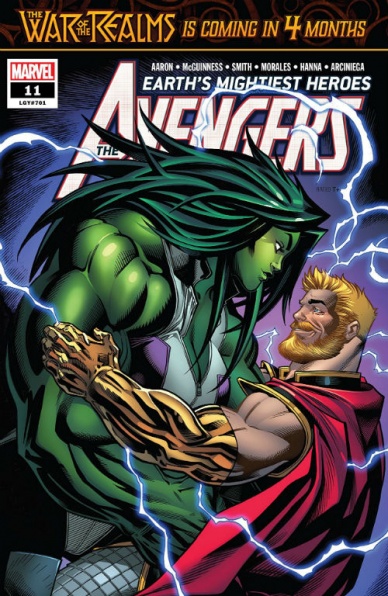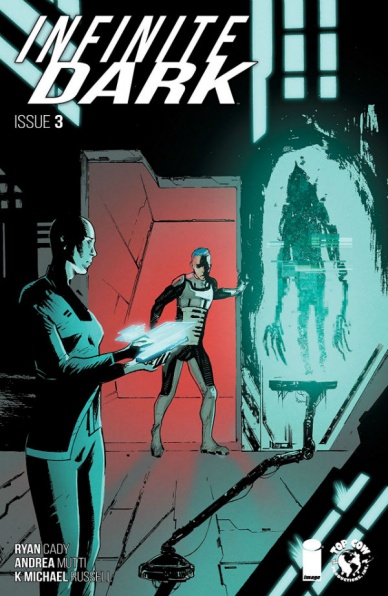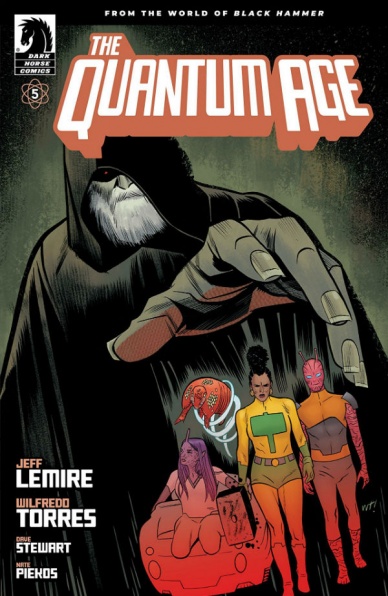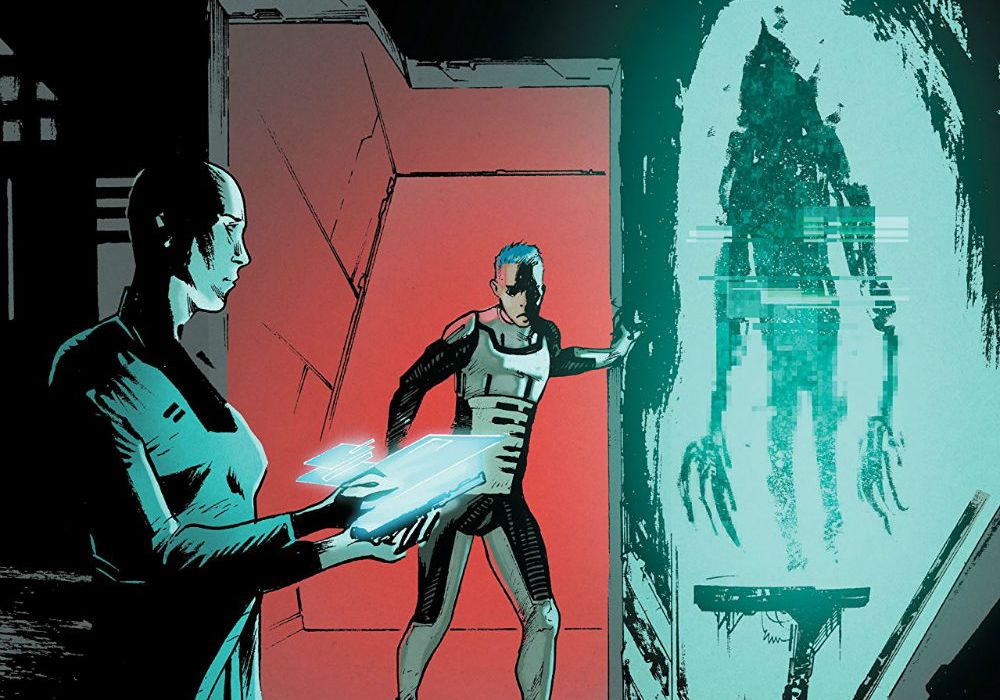There is a lot to cover on Wednesdays. We should know, as collectively, we read an insane amount of comics. Even with a large review staff, it’s hard to get to everything. With that in mind, we’re back with Wrapping Wednesday, where we look at some of the books we missed in what was another great week of comics.
Let’s get this party started.

Written by Jason Aaron
Penciled by Ed McGuinness & Cory Smith
Inked by Mark Morales, Scott Hanna & Karl Kessel
Colored by Erick Arciniega
Lettered by VC’s Cory Petit
Reviewed by Gustavo S. Lodi
After the turbulent first issues of his run on “Avengers,” Jason Aaron steers the book into a quieter issue, that adds much-needed nuance to character interaction and clarity to ongoing subplots.
Avengers is, arguably, the flagship title for the Marvel Universe, so some expectations come with the territory: big battles, and never-seen-before deathtraps. Still, when asked about their seminal runs, readers will usually point to deep character relationships and specific individual moments. If that was missing from the first ten issues of Aaron’s run, it definitely spikes up on this one.
With McGuinness and Smith sharing penciling duty, with the support of Morales, Hanna and Kessel on inks, “Avengers” #11 manages to balance multiple styles for a story that jumps around. If the international heroic committee is painted in more traditional lines, there is still plenty of big heroes to be seen elsewhere. It is not a significantly beautiful issue, but it is one where narrative flows seamlessly, despite the change in artists.
On this more plot-oriented tale, the words by Aaron take center stage. It is quite interesting to observe Black Panther starting to lay the foundations for a more collaborative internal committee, removed from his days with the Illuminati. It is just as compelling to witness a character return, but with a darker outlook in life.
In traditional gathering fashion, Aaron also spends some time in a smaller group of characters, such as Captain Marvel offering Ghost Rider a much-needed pep talk and orientation, as well as the blossoming romance between Thor and She-Hulk – with some insightful discussions on the nature of dual identities thrown in for the mix.
While not groundbreaking, “Avengers” #11 gathers the pieces of the game board before the inevitable next big event. It adds gravity to these characters and their challenges so that when they are next in danger, the stakes will feel more personal.
Final Verdict: 7.1 – Aaron and team weave in the personal angle of these heroes lives before the proverbial storm hits. By making it more grounded, it lays the base for explosive combat in the future.

Written by Steve Orlando
Illustrated by Travel Foreman
Colored by HI-FI
Lettered by Travis Lanham
Reviewed by Alexander Jones
Despite the high volume of content currently published by DC Comics, a hard sci-fi title set in the distant future featuring aliens and gladiator fights still manages to stand out among the pack. The bleak sci-fi tone and aesthetic of “Electric Warriors” immediately caught my attention with the fast-paced debut chapter.
Thanks to the tone writer Steve Orlando and artist Travel Foreman bring to “Electric Warriors,” the title is unmistakable for any other book on store shelves. The series is a sci-fi tournament set in the far future featuring a lead character bearing a rough attitude that is easily traceable to some of the finest work from Orlando at DC. The story goes beyond surface level interaction and fleshes out the greater relationships between the aliens and humans from a political standpoint as well.
Foreman’s unconventional linework and Hi-Fi’s chilling, subtle colors depict a bleak direction and personality for the issue. Foreman’s action scenes in the issue are staged with dynamic poses. Orlando still has the issue broken up into chapters, which adds a great break and approach to the story. At times, the colors in the issue can be too bright especially when readers are looking at the comic on a computer screen. Foreman’s backgrounds can look too simplistic at times as well. Despite the artwork of the issue carrying a few noticeable flaws, the different aliens in the issue have an interesting design and all look unique.
Continued below“Electric Warriors” has done an excellent job following up on the cliffhanger from the previous issue and introducing an intriguing new cliffhanger for this installment. Orlando’s script deepens the intrigue of the series, depicting the fractured mental state of the protagonist. Orlando’s script also has a solid pace, introducing readers to the different supporting players around the story while advancing the overall plot. The comic also has a few action-packed fight scenes. “Electric Warriors” #2 continues the bold approach to the story and artwork of the series while retaining a few core DC elements and mysteries to keep me starved for more content.
Final Verdict: 7.7 – “Electric Warriors” #2 is loaded with pulse-pounding fight scenes and intriguing intergalactic drama.

Written by Ryan Cady
Illustrated by Andrea Mutti
Lettered by Troy Peteri
Colored by K. Michael Russell
Reviewed by Christa Harader
“Infinite Dark” has a unique take on the void staring back. The book does good work in its hard sci-fi milieu, and issue #3 cuts out some of the background chatter of the previous issues as the station teeters on the verge of collapse.
Cady’s conceptual reach here is impressive, as is his ability to balance multiple character threads. I could argue that there’s one too many, but the book’s a close-up experience and the extra noise suits. Mutti’s dealing with what he does best – finely rendered sci-fi with some close-up character action. There is some confusion between character faces at times, though, especially when Deva’s wearing her suit and speaking to Kirin. Russell’s palette is a bit more stylized than in previous issues, with some nice contrast color pops as the action begins to intensify. The characters’ headlamp flares and other light sources are a little too bright sometimes and can wash out some of Mutti’s finer line.
I tend to gripe about wider-set typefaces, but Peteri’s choice here softens the edges of the sterile environment and adds just a touch more emotion to each scene. Most of the characters in this book are trying desperately to hold onto some kind of order in the literal encroaching chaos, and the lettering style reflects that nicely. Narrative boxes are tinted beige, and SM1TH’s stylized boxes do well to set that voice apart from everything else on the page, especially when there are multiple speakers. I appreciate the red lettering for readability, though the red text does clash with the beige background.
Overall, “Infinite Dark” is a book that’s struggling, both on and off the page, to face oblivion – and that’s not to say the book is failing. It’s a hard concept to grasp, much less illustrate for others, and Cady and the team do a solid job getting us there.
Final Verdict: 7.0 – “Infinite Dark” #3 digs deeper into the mystery the series is trying to set up, with a nice cliffhanger to see us through.

Written by Jeff Lemire
Illustrated by Wilfredo Torres
Colored by Dave Stewart
Lettered by Nate Piekos of BLAMBOT
Reviewed by Elias Rosner
Colonel Weird has had a tough life, driven mad by the knowledge of the parazone and his guilt over all that occurred on the farm. For those who read “Black Hammer” and “Black Hammer: Age of Doom,” this comes as no surprise but for those whose entry to the Hammerverse is through this Legion of Superheroes homage, “The Quantum Age” #5 introduces the wayward Colonel and his plight without ever feeling like it’s retreading ground. This is a tough tightrope to walk but the “Quantum Age” team pulls it off with gusto, building the story started in the main title, reflecting it, but never rely on it.
Weird floats through the parazone, presented as a Paquette-esque kaleidoscope of eyes, nerves, and colors, forming the borders of past events, with him just repeating his apologizes to everyone. The why is unimportant, although we do get some context for why he apologizes to Talky-Walky, what matters is the sentiment and the guilt. It frames his actions and contextualizes them for us and for the Quantum League. It also helps provide the heart of the issue.
Continued belowWhen Talky & Weird reunite, there is a palpable sense of how much time has passed. Torres draws Weird hunched and pulled inward by his guilt, Talky is tired, her hands on her thighs, her speech rife with anger but also sadness and loneliness. Less powerful is the reunion between Archive and Black Hammer but only because it is cut short in order to further the larger plot and to allow for more space for Talky & Weird. This may do a disservice to this miniseries, and this issue, as a standalone piece, but as a story that is meant to complement the main title, these moments heighten the universe and make it feel interconnected in ways that the big 2 do not.
Not much happens in terms of grand battles but that is reserved for next issue. Despite this, there is still much to love in “The Quantum Age” #5.
Final Verdict: 7.7 – The penultimate issue of “The Quantum Age” proves itself to be a powerful story of reconciliation and connectivity in spite of the slowing down of the rest of story this creates.

Written by Brandee Stilwell
Illustrated by Ron Randall & Gus Vasquez
Lettered by Dave Sharpe
Colored by Ross Campbell & Chris Sotomayor
Reviewed by Michael Govan
“Sasquatch Detective Special” is all about a…well, a sasquatch detective. The premise is pretty straightforward, there aren’t any twists or extra layers to the whimsical idea. The issue follows the enthusiastic Tonya Lightfoot, who left behind her life in the forest to become a cop with the Los Angeles Police Department. The book starts with the sasquatch’s origin story and then readers are treated to several of her adventures with the police and her partner Ron.
This is a lighthearted and comedic book that, while rated T+, could get away with ‘all ages’ with a few minimal changes. Humor is largely subjective and the comedy might not work for everyone across the board. A lot of the comedy in “Sasquatch Detective Special” is physical, Tonya’s various disguises doing very little to hide that she’s a giant forest creature. There’s plenty of jokes about how bad a Sasquatch smells when wet. Personally, a lot of these jokes didn’t land for me, making the reading a pretty neutral experience. While I found Tonya pretty amusing, the giant special was definitely too much of a good thing. If you disagree, if the small doses aren’t enough, you’re in luck. There’s plenty Sasquatch to go around in this oversized issue.
Final Verdict: 5.5 – There is SO much Sasquatch Detective…

Written by Jody Houser
Illustrated by Luke Ross
Colored by Java Tartaglia
Lettered by VC’s Travis Lanham
Reviewed by Chris Egan
The newest “Age of Republic” one-shot, entitled ‘Ash,’ is follows Darth Maul shortly before the events of The Phantom Menace. While a well-written comic with a quick story by Jody Houser (“Faith and the Future Force”), it seems to lack any real depth or grand scheme purpose. However, with more “Age” comics on the way spanning the eras of all three trilogies perhaps we will get more from what makes this Maul story important, or maybe not.
The information we get from this story is neither pressing nor nothing that wasn’t already implied or shown in previous stories. His anger towards the Jedi and any person or creature he sees as inferior, his relationship with Darth Sidious, and his animal-like brutality. And it doesn’t even begin to scratch the surface of the larger arcs of Maul’s life that we’ve received in superior stories in comic books and the two t.v. series that resurrected him, The Clone Wars and later on, Star Wars: Rebels. It is not a bad comic, it just feels too light and unnecessary at this point. It toys with the idea that Maul could have been set on a Light Side of the Force path in life, but it fails to really capture a sense of loss for the life that could have been.
Luke Ross’s (“Star Wars: Thrawn,” “Hulk”) art is great and immediately pulled me back into some of the better qualities from the prequel trilogy. He perfectly captures the likenesses of Ray Park and Ian McDiarmid in their portrayals of Maul and Sidious, respectively. And his eye for prequel-era designs brings the settings, like the city-planet, Coruscant, to life. Java Tartaglia (“Uncanny Inhumans,” “X-Men: Gold”) does an incredible job with the color. Making Ross’s feel like you are stepping right into the prequel era. His use of light and shadow also brings a mysterious and, at times, dream-like quality to the book as a whole. With Maul’s dealings with the dark and dangerous side of the galaxy, his work perfectly expresses the tone of the story.
Continued belowSome mild nostalgia aside, what we get is an OK Darth Maul story that does not really add anything to the greater mythology, but it is a well-executed effort. Unfortunately, it looks like it needs its “Age of…” companions to hold it up rather than working on its own AND as a piece of the greater picture. With how many great “Star Wars” comics we have gotten from Marvel in the last few years, they seem to stumble with Maul as a character. Not sure if it’s the fault of the writers or if it’s just time to retire the character, especially now that his story has been fully told. Also, in true Marvel fashion, it felt like every other page was an ad, so constantly being bumped out of the story did not do the narrative any favors, and makes for a lighter issue than it should have been.
Final Verdict 5.0 – A dark and angst-filled Sith adventure that looks great and is decently told, but holds little weight while re-treading existing material.

Written, Illustrated & Colored by Albert Montyes
Lettered by Barbaink
English Editing by Ryan Williamson
Reviewed by Tom Shapira
The one-man anthology is back after a long (long) absence with 40 pages and about 30 short stories: some last several pages, some get one, some are presented as mere snippets – a single panel. Surprisingly enough it’s the shorter stories that work best, offering us hints and ideas and letting us build world and character around them in our mind.
The longer pieces suffer, in compression, by either offering ‘futureshock’ type twist endings which are not very surprising, like “15 Years and a Day” or “At the Speed of Light” (both of which will be extremely familiar to anyone who ever read a science fiction anthology before); or by giving us stale social critique, such as “Williams’ Gift,” which almost seems like a parody of the Black Mirror.
Still, the stories are so short that even the bad ones pass by quickly, and with over forty pages of story (with the Panel Syndicate pay-as-you-please model) you certainly feel you got a bang for your buck. Albert Montyes’s art remains a pleasure to look at: he knows to use the form and size of the page to manage the flow of story very well (one story has 36 panels per page and remains readable without needing to adjust the view size). He’s particularly good at framing the action and reactions – check out the final page of “At the Speed of Light” for how well he presents the finishing punchline, a small moment at the bottom of the page in the middle of a huge celebration.
Final verdict : 7.0 – more hits than misses, but the stories certainly needed a more original approach if they aim to impress.

Story by Cullen Bunn & Blacky Shepherd
Written by Cullen Bunn
Illustrated by Blacky Shepherd
Lettered by Taylor Esposito
Reviewed by Ken Godberson III
Well that was dull, wasn’t it?
Vampirella and Herbert West, the Re-Animator, are two of the more culty horror icons around. The vampire from another planet and the science-based necromancer both have a panache for sly humor tinged in their horror, so on paper, these two could provide an interesting and fun crossover. However, if we are going by the contents of this first issue, “fun” and “interesting” seem like they will be very far away. The biggest problem this issue has is that it spends so much time introducing who these two characters are in very basic ways. It gets very wordy at times, trying to make sure the layman is up to speed on who these two characters are. But it’s very dry, showing Dr. West searching through an old monastery and Vampirella hunting some werewolves. The ending provides a link (the two titular characters don’t even interact in the first issue), but by that point, it feels like the audience is lost.
Perhaps the most interesting aspect of the book is some of the artistic choices Blacky Shepherd makes. He chooses a mostly grayscale color scheme, trying to invoke some of the older horror comics while utilizing more modern pencils. The only color we get is the crimson red for the blood on both sides of the story, which makes for an intriguing enough visual. One criticism of the artwork is that in some cases the facial expressions could be a bit stiff. It works a bit more with someone like West, but then you have a would-be victim of werewolves who is supposed to be conveying fear but you don’t really feel it based on the expression.
“Vampirella vs. Re-Animator”’s first issue is a miss. Not bad, but just very unremarkable outside of some visual quirks. What could’ve served this better is, to be blunt, just damn the layman and go full hog into it, assuming the reader knows who these characters are (and considering the cult nature of these two, that’s more likely) instead of wasting so much time on set-up. But because of that, we got something that feels very much like a stock crossover beginning.
Final Verdict: 4.8 – Some interesting visuals can’t shield over a very dull script.






